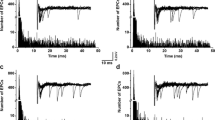Summary
The detubulated neuromuscular preparation was stimulated by several thousand stimuli at the rate of 10–20 Hz. During the stimulation there was an exponential decay in transmitter release from the presynaptic terminal. The fraction of the existing store of quanta released by a single pulse was about 0.001. This value is two orders of magnitude smaller than that obtained from short tetanic trains. The discrepancy was attributed to the process of mobilization which sets in during prolonged stimulation of the synapse. A simple analysis shows that the amount of transmitter mobilized after each nerve impulse is a constant fraction of the existing store of quanta.
Similar content being viewed by others
References
Barker, L. A., Dowdall, M. H., Essman, W. B., Whittaker, V. P.: The compartmentation of acetylcholine in cholinergic nerve terminals. Drugs and cholinergic mechanisms in the CNS, p. 193–223. Ed. E. Heilbronn and A. Winter. Stockholm: Forsvarets Forskningsanstalt 1970
Bennett, M. R., McLachlan, E. M.: An electrophysiological analysis of the storage of acetylcholine in preganglionic nerve terminals. J. Physiol. (Lond.)221, 657–668 (1972)
Betz, W. J.: Depression of transmitter release at the neuromuscular junction of the frog. J. Physiol. (Lond.)206, 629–644 (1970)
Christensen, B. N., Martin, A. R.: Estimates of probability of transmitter release at the mammalian neuromuscular junction. J. Physiol. (Lond.)210, 933–945 (1970)
Collier, B.: The preferential release of newly synthesized transmitters by a sympathetic ganglion. J. Physio. (Lond.)205, 341–352 (1969).
del Castillo, J., Katz, B.: The membrane change produced by the neuro-muscular transmitter. J. Physiol. (Lond.)125, 546–565 (1954)
Dunant, Y., Gautron, J., Israel, M., Lebats, B., Manaranche, R.: Acetylcholine compartments in stimulated electric organ of Torpedo Marmorata. J. Neurochem.19, 1987–2002 (1972)
Elmqvist, D., Quastel, D. M. J.: A quantitative study of end plate potentials in isolated human muscle. J. Physiol. (Lond.)178, 505–529 (1965)
Hebb, Catherine: Biosynthesis of acetylcholine in nervous tissue. Physiol. Rev.52, 918–957 (1972)
Howell, J. N., Jenden, D. J.: T tubules in skeletal muscle; morphological alternations which interrupt excitation contraction coupling. Fed. Proc.26, 553 (1965)
Hubbard, J. I., Jones, S. F., Landau, E. M.: The effect of temperature change upon transmitter release, facilitation and post-tetanic potentiation. J. Physiol. (Lond.)216, 591–609 (1971)
Liley, A. W., North, K. A. K.: An electrical investigation of effects of repetitive stimulation on mammalian neuromuscular junction. J. Neurophysiol.16, 509–527 (1953)
Lundberg, A., Quilisch, H.: Presynaptic potentiation and depression of neuromuscular transmission in frog and rat. Acta physiol. scand.30, Suppl. III, 111–120 (1953)
Martin, A. R.: A further study of the statistical composition of end plate potential. J. Physiol. (Lond.)130, 114–122 (1955)
Takeuchi, A., Takeuchi, N.: Further analysis of relationship between endplate potential and end-plate current. J. Neurophysiol.23, 397–402 (1960)
Thies, R. E.: Neuromuscular depression and the apparent depletion of transmitter in mammalian muscle. J. Neurophysiol.28, 427–442 (1965)
Author information
Authors and Affiliations
Rights and permissions
About this article
Cite this article
Lass, Y., Halevi, Y., Landau, E.M. et al. A new model for transmitter mobilization in the frog neuromuscular junction. Pflugers Arch. 343, 157–163 (1973). https://doi.org/10.1007/BF00585711
Received:
Issue Date:
DOI: https://doi.org/10.1007/BF00585711




